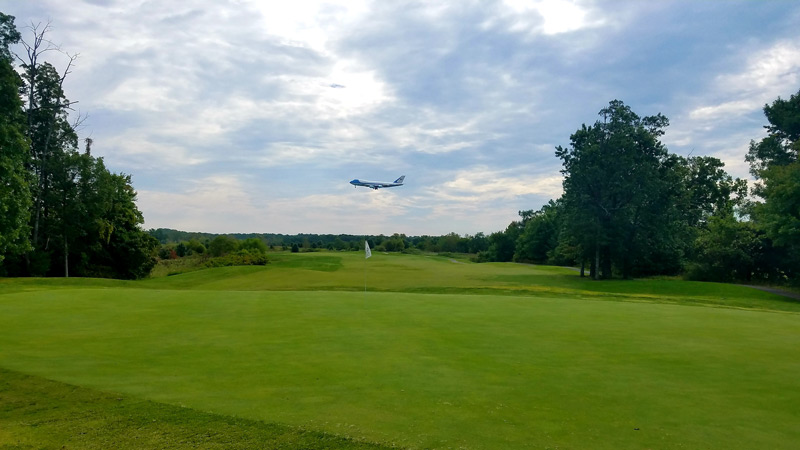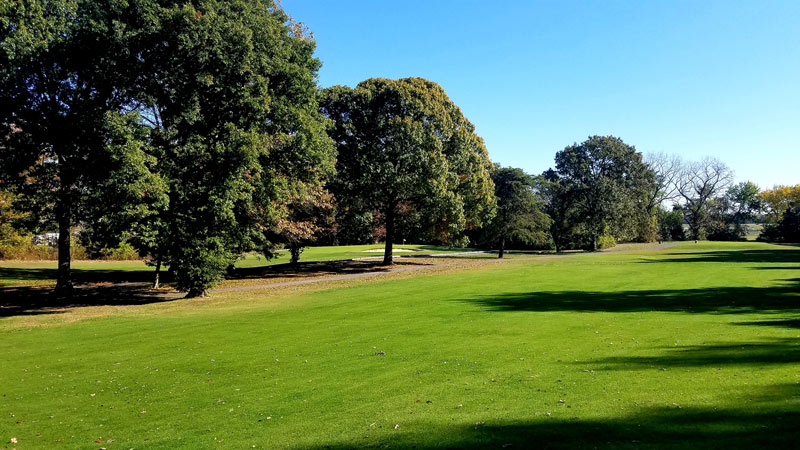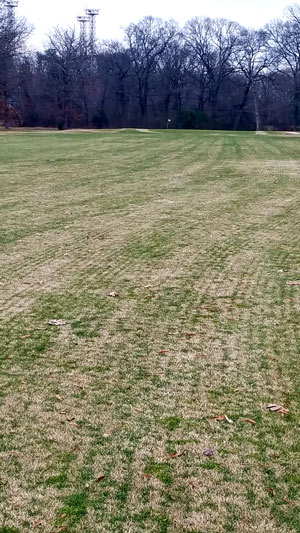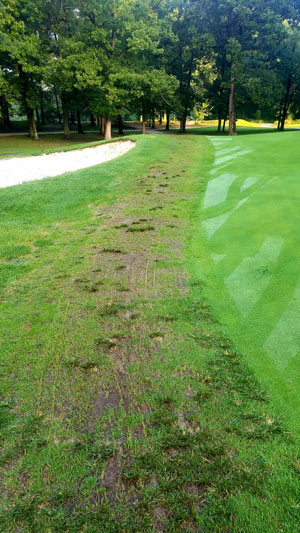
Air Force One soars above The Courses at Andrews, located on Andrews Air Force Base in Maryland, in September 2017. The U.S. president typically flies out of Andrews Air Force Base when traveling from Washington, D.C., making the aircraft a regular sight at the golf facility. Photos courtesy of Ben Ellis
Editor’s note: The following is adapted from the book The First Hundred Days: Becoming a Golf Course Superintendent and Living to Tell the Story by Ben Ellis. Ellis, who is currently the GCSAA Class A superintendent at Fort Belvoir (Va.) Golf Club, writes about his nine years (two of those years as head superintendent) at The Courses at Andrews, a 54-hole facility located on Andrews Air Force Base, just outside Washington, D.C. The book chronicles the challenges — dead greens, aged equipment, a shoestring budget, inhospitable weather — Ellis and his team faced maintaining the military golf facility, and the wisdom found in both the successes and the setbacks.
Overseeding fairways is common in the southern United States. There, golf courses cut down their bermudagrass as low as possible using special equipment like a verticutter or fraze mower, which can cut through the tough bermudagrass to get close to the soil surface. Next, they drop or spread seed using a rotary spreader. Crews follow that up with either a drag brush or steel mat to move the seed closer to the soil, and then water is dumped on the fairways for a few weeks, making them as wet as a rice field to allow for good seed germination and establishment. Often, courses close completely during this process or, at a minimum, restrict carts to the path while the heavy amounts of water are being applied.
Every winter, I go down to play in Myrtle Beach, S.C., for a few days with my dad and some friends. Many golf courses there overseed fairways with ryegrass to have something actively growing during their busy winter season, when the bermudagrass goes dormant. The golden-brown or tan rough with the emerald-green fairways, tees and greens is a marvelous sight.
This look of lush, green fairways was what Richard and Harvey, my bosses, were expecting when they asked me to overseed at The Courses at Andrews. Located on Andrews Air Force Base just a few miles southeast of Washington, D.C., The Courses at Andrews was, at the time, the largest military golf facility in the world, with 54 holes spread over nearly 900 acres. The venue has been a favorite retreat for several U.S. presidents. (I was always asked, “What do you do special when the president comes to play?” The simple answer: nothing. I usually wasn’t told when the president would be playing, so there was never time for any special prep. It was honestly just another day.)
All three courses at The Courses at Andrews had Vamont bermudagrass on fairways and tees, and greens were a mix of bentgrass and Poa annua. Richard and Harvey were convinced that tan and brown fairways in winter and spring led to lost revenue, so they were insistent on overseeding, which hadn’t been done on the courses in several years at that point.
I’d never had success with simply broadcasting seed onto the fairways. We didn’t have a verticutter or a fraze mower, which meant we couldn’t get down close enough to the soil surface, so we always had seed drying out or dying on the surface. In my ideal seeding scenario, the courses would close for two weeks while the fairways received the heavy irrigation needed for seed establishment. Then, for a few weeks after reopening, carts would be restricted to the path to protect the young grass.
Neither of these was an option, however. Management wanted the courses to remain open during overseed, and, because cart rental made money for the facility, they didn’t want to limit cart use to the paths. To complicate matters further, the instruction to overseed came down just about a week before the East Course was to host some important outings.

Superintendent Ben Ellis broadcasts ryegrass seed on the 15th hole of the East Course at The Courses at Andrews.
It was the first week of September in 2017, about two and a half months into my tenure as head superintendent, and I had to come up with a strategy. I decided that slit-seeding ryegrass would be our best option for getting good seed-to-soil contact with the least disruption to the turf. In slit seeding, discs cut down just slightly into the soil surface to make a small channel, and seed from a hopper gets dropped down directly into the new slits.
I felt confident we’d get seed established with this method, but the process was going to take some time, as we only had one seeder that attached to a tractor. With the tight time frame and the inability to keep cart traffic off fairways, I had my doubts this overseed would turn out well.
Prepping and planning
After making several phone calls about seed rates and pricing, and after reading every article I could find about overseeding fairways in the Mid-Atlantic, I decided to go with a high rate of 10 pounds of seed per 1,000 square feet. A typical bag of seed weighs 50 pounds. That meant we wanted to put down 435.6 pounds of seed per acre, and we needed enough seed to cover the 32 acres of fairway turf on the East Course, which came out to 14,000 pounds (rounded up from 13,939.2 pounds) of perennial ryegrass seed.
The seed wasn’t cheap. By purchasing in bulk, we were able to get a reduced price, but the seed for the East Course alone came to around $15,000. When I brought this up to Richard and Harvey, they decided to proceed with overseeding just the East Course. Their hope was that doing so would increase play and membership during the winter months and leading into spring. Also, given the high likelihood that we were soon going to lose several holes on the East Course because of the construction of a new Air Force One hangar, we’d be going out strong.
I knew what Richard and Harvey wanted, but, given the circumstances — not closing the course or restricting carts, fast turnaround, limited equipment — and my past experience working in our northern climate, I didn’t think the return would be what they imagined. It definitely wouldn’t generate over $15,000 in added winter and spring play on a Mid-Atlantic golf course. (The additional $15,000 was just for the seed and didn’t factor in the crew’s labor, the fuel to keep the tractor running all day, or the fertilizer to get the seed started.) I was in a tough spot, but I had to do the best I could to make it happen.

The overseeded ryegrass emerged before the bermudagrass went dormant on holes 6 and 7 of the East Course.
I ordered the seed for the East Course, and Joe, our tractor operator and foreman, and Mike, our mechanic, got the seeder hooked up on our tractor with the front-end loader bucket attached. This way, we could keep a few bags of seed in the front bucket at the ready, saving us the time of traveling back and forth to the shop or another location to fill up the hopper. We were using an old Jacobsen 548 slit seeder that had been around for years but always got the job done. With the seeder attached to the back of a tractor, seed dropped down from a box through several tubes and was placed into grooves made by cutting wheels, which gave the seed the soil contact needed for germination.
On Monday, Sept. 4, with the seeder hooked up and seed arriving any second, we went out to prepare the fifth fairway. Anytime I calibrated our spreader, seeders or sprayers, I always tried to use either hole 5 or hole 11 of the East Course. Those holes were completely flat, and I measured the square footage out every year, so I knew exactly how large the fairways were. Right as we were getting started on hole 5, I got the call that our seed had arrived. Perfect. Now we were all in.
The original plan for the overseed was as follows:
- Brush the fairway with the Sweep-N-Fill brush to stand up all the grass.
- Mow the fairway at exactly half an inch with the mower going 3 mph for a nice, clean cut.
- Slit-seed in one direction from the beginning of the fairway to the end at the most open setting possible on the Jacobsen seeder (about 5 pounds of seed per 1,000 square feet).
- Slit-seed in a second direction at a 45-degree angle to get the best possible coverage.
- Use the tow-behind Lely spreader to broadcast the remaining 5 pounds of seed per 1,000 square feet onto the fairway.
- Use a metal drag mat to push the broadcast seed below the turf canopy.
- Irrigate the fairway for 10 minutes per irrigation head three times per day or as needed.
Picking up the pace
That Monday, Joe went to town with the seeder on No. 5. You could see every line the seeder was making in the fairway, and it was beautiful. The seed was dropping down perfectly, and I felt a glimmer of optimism. The mowing and brushing were going quickly, but the slit seeding was taking longer than I’d expected. Richard and Harvey had originally asked me whether we could rent another seeder to speed up the process, but I hadn’t been able to find a tractor-mounted seeder available to rent. Joe couldn’t go any faster without risking the seeder getting damaged.
After Joe got done with No. 5, which took him two hours, we jumped over to No. 2, where there was a gap in play. We never closed the course during the overseeding process, so the entire time, we had golfers playing and hitting balls toward the tractor. On hole 2, Joe was able to get the first seeding pass done before the end of the day. We’d tackle the second, 45-degree-angle seeding the next morning.

Right: An overseeded fairway in December 2017. The slit-seeded lines became evident after the bermudagrass had gone completely dormant for the winter.
My original projection had been to seed three or four holes per day, allowing six days for the process from start to finish. I thought six days was plenty of time to drive up and down the fairways for eight hours a day. I realized that first day, though, after we’d finished just one and a half fairways, that I needed to make some adjustments.
We couldn’t hold off seeding for a month, when the big outings and events would be over, as Richard and Harvey had initially wanted, because I was worried the bermudagrass would be going into dormancy by that time, and I didn’t want to risk weakening the turf heading into winter.
I talked it over with Joe and Mike, and we came up with a plan we hoped would work. The idea was to get seed down in at least one direction on all the fairways before we had to stop for the scheduled outings, and then we’d do the 45-degree-angle seeding two to three weeks later, in late September, after all the outings were in the books.
Joe finished the 45-degree slit seeding on hole 2 around 8 a.m. the second day. After that, I had him slit-seed in only one direction, straight up and down, and on only the par-4 and par-5 holes. He went from completing work on one and a half fairways a day to finishing four or five. I followed behind Joe and broadcast seed with our Lely spreader, and we used a drag mat to brush in the seed.
Reviving a seeder
Hidden in the back of the barn, we had an old Toro Groundsmaster unit with a box seeder attached to the front. We only used it once a year for seeding tees or rough if needed. The little seeder was so front-heavy that its back wheels would sometimes lift off the ground, and it was a nightmare to steer. We were going to have to be patient with it, though, because it was ultimately going to help us get the overseeding job done.
While the other seeder was working the bigger fairways — the East Course had four par-3s, 10 par-4s and four par-5s — we’d use the smaller seeder to tackle seeding the par-3 fairways along with all collars and approaches.
Mike got the machine up and running, and he made a ball hitch to go on the back of the seeder so we could tow a small trailer around the course with seed. Once he was done with the maintenance of the machine and had bags of seed piled in the trailer, I went out for a test drive on hole 4.
The East Course’s fourth hole was a 165-yard par 3 with a large bunker on the left side and two smaller bunkers on the right. I wanted to try something different with the little seeder. With this being a par 3, we could move a little faster, so I decided to go in an X-like pattern. I wanted to avoid going back and forth in the approach of the green, and this seemed to work for the shape of the hole. I was able to knock out the fairway overseeding in two directions and make a few extra passes right in front of the green to make everything blend nicely.
The little Toro seeder was very aggressive, even on its lowest setting. I tried taking the seeder around the green on No. 8, where Joe was working on the fairway. The seeder tore the collar apart, ripping up all the crabgrass and sandy soil. I hopped off the seeder and went around the collar, replacing all the patches of turf I’d just torn up. I decided we’d overseed the collars by broadcasting the seed and using a brush to get it under the turf canopy.

Right: A collar in the aftermath of the small seeder.
The next morning, I sent our operator, Kenny, out with the little Toro seeder to seed the rest of the par-3 fairways and all the approaches. If we used the little seeder to cut slits in the approaches on the larger fairways, the seeding would blend in where Joe’s tractor seeder couldn’t reach.
After Kenny had finished the par-3 fairways and the approaches, I had him start seeding the tee boxes. With both seeders out in full force, we were on track to get the first stage of the seeding done before we had to hold off for a few weeks for the golf outings.
Editor’s note: Expanded use of colorants beyond shoulder seasons and winter dormancy prompted researchers to investigate how such products affect light reaching turf. Read their findings in Just passing through: Turf colorants and light transmission.
Cleaning up behind the seeders ended up being quite time-consuming. The seeders would leave clumps of torn-up bermudagrass, thatch and soil all over the fairways and approaches. We couldn’t use a blower because of the risk of blowing away the seed with the grass clumps. I talked Mike into raising the fairway mowers a little, and we started cutting up the clumps in the afternoons, when the fairways were free from dew and moisture from irrigation, working as quickly as possible so the debris wouldn’t detract from golfers’ enjoyment.
After a few long days with the staff working late, by that Friday, we had the first round of slit seeding done on all the fairways and had broadcast additional ryegrass seed. We followed up the seeding with a substantial amount of water to get the seed wet.
The next and most critical step was to keep the new seeds wet. If the seeds dried out, then everything we’d done was for nothing. As much as I wanted to apply more water to the fairways multiple times each day to maintain moisture, as the textbooks say to do, I wasn’t able to restrict golf carts to the paths. This would have been a perfect time for a few good days of soaking rain, but alas, the weather was hot and dry. We watered every chance we got from the time we finished seeding on Friday to when the outings began on Monday.
Reflections on a speedy overseed
About a week after Joe had done the initial slit seeding, right around the start of the outings, the ryegrass was coming up in rows, like a cornfield. It looked really cool, and it was a relief to see the seed was taking root. Ryegrass germinated quickly and gave a new-growth look and dark color. As the fairways were starting to green up, the greens had nearly healed from aerification in August. The course was starting to look good again after we’d torn it up on purpose.
Golfers would stop me to tell me how good the “dethatching” looked — they’d never seen such a thing done before. Although dethatching wasn’t the intent of the slit seeding, any compliments were rewarding for the staff after they’d devoted so many hours to the project. While I always tried to make sure my team knew how much I appreciated their work, I knew hearing praise from golfers always meant more.

The 18th hole of the East Course in spring 2018, following the fairway overseed. The overseeded ryegrass greened up ahead of the bermudagrass.
In the end, overseeding the East Course returned the results I had expected, though not what my employers had expected. The ryegrass seed germinated like crazy, and in the sea of tan and gray bermudagrass, thin, dark green rows appeared in two different directions, showing every spot the seeder had placed seed. This look had been my initial goal and was why I had chosen to slit-seed. My bosses had envisioned full, thick, lush green fairways throughout the winter months, which just wasn’t realistic.
The ryegrass looked its best the following spring and produced exceptional dark green fairways that were able to be striped with the fairway mowers to be on par with those of any world-class golf course. The bermudagrass made it through the winter just fine, though it was slower to green up than in years past.
I haven’t overseeded a fairway since this experience, and perhaps the biggest lesson I’ve learned is to consider newer varieties of bermudagrass. These varieties are more cold-tolerant, keep a denser stand of turf, and, in my experience, provide just as nice of a playing surface as bentgrass or ryegrass fairways, without the high seed cost or the need to regularly treat with fungicides.
Ben Ellis is the GCSAA Class A superintendent at Fort Belvoir (Va.) Golf Club, a position he has held since January 2020. He first worked at the 36-hole facility in 2003. A 15-year GCSAA member, Ben is the current president of the Maryland Turfgrass Council. He has a passion for golf history and has worked in the maintenance departments at Laurel Hill Golf Club in Lorton, Va., The Courses at Andrews in Maryland, and Paint Branch Golf Complex in College Park, Md. When not on the job, Ben enjoys spending time outdoors with his wife, Sara, and their dogs, Bruce and Leia.